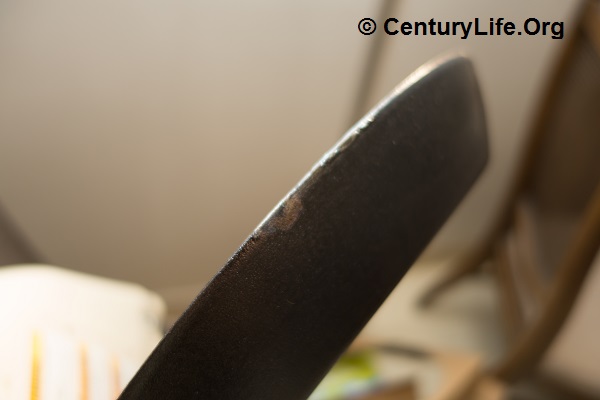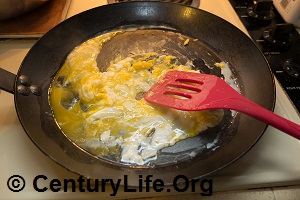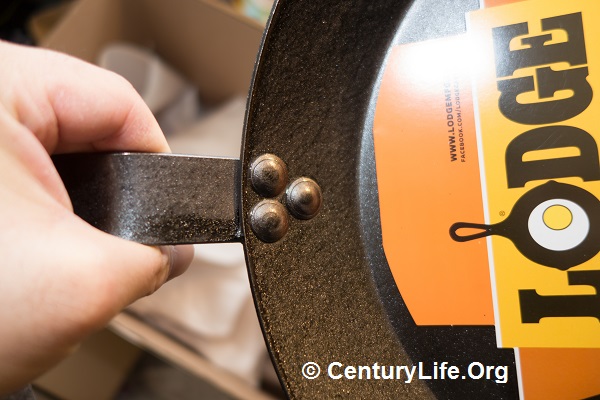THE COMPANY
There used to be many American cast iron manufacturers from the 1800s and 1900s, but Lodge Manufacturing is the only survivor, making it something of a hometown favorite, or home-country favorite, if you will. The company originated with Joseph Lodge and is still a private, family company to this day. Its main foundry is still in the original town of South Pittsburg, Tennessee, where bare cast iron cookware is made. Lodge’s enamel-coated cast iron cookware is made in China.
Lodge has had its ups and downs, surviving downturns like the Great Depression by making iron ornaments and sculptures. Lodge has had a Renaissance since 2002, when it introduced pre-seasoned cast iron rather than require that customers build up their own layers of seasoning–something that no doubt intimidated people using raw cast iron for the first time. The pre-seasoning also helps protect the product against rust.
Lodge also gained customers in the 2000s due to fears about the safety of PTFE such as Teflon and/or aluminum exposure, cost (initial cost is low and cast iron can last a century or more if not abused, though longer preheat times mean a higher long-term cost), distrust of the purity and quality of Chinese-made cast iron, need for induction-compatible cookware, and nostalgia for the past. Until 2015, when new environmental regulations kicked in, production of PTFEs also used PFOAs, an environmental pollutant.
Carbon steel has become more popular in recent years as a lighter-weight alternative to cast iron. Lodge noticed, and in 2011 it debuted its first carbon steel pan.1
Carbon steel is ~99% iron so it shares thermal characteristics with cast iron, including weight and relatively poor heat conductivity compared to aluminum and copper. So why get carbon steel instead of cast iron? Because cast iron is brittle, but carbon steel is less brittle, so you can make carbon steel pans thin and yet avoid breakage. You can think of carbon steel as thin cast iron that has a somewhat smoother finish and a small amount of carbon to give it strength.
Since carbon steel is like Cast Iron Lite, it shares the advantages and disadvantages as well:
Advantages of Carbon Steel:
– Ability to be seasoned with baked-on oil that polymerizes into a semi-nonstick surface; some people prefer this over PTFE such as Teflon
– Induction-compatible since it’s magnetic
Disadvantages of Carbon Steel:
– Rusts when exposed to water, unless protected by a coat of seasoning and/or heated after each washing to evaporate water quickly
– Poor heat conductivity leads to relatively uneven heating
Let’s examine that last one for a moment. Thick cast iron is already a poor heat conductor, so you wind up with uneven heating on anything but the lowest power settings/flame. You can work around this problem sometimes, such as by continually rotating food around the pan so that each piece gets its fair share of time above the hottest portion of the pan. However, in some cases you may be cooking multiple things and can’t devote 100% of your attention to one pan. And some things aren’t as easily stirred as others, such as delicate fish.
Carbon steel, being even thinner than cast iron, is even more uneven-heating than cast iron.
So the tradeoff between carbon steel and cast iron becomes less weight and smoother surface (carbon steel) vs. more weight and somewhat better heat distribution (cast iron).
I think the logic goes: “If I’m going to use either carbon steel or cast iron, I am going to have to babysit the pan, stirring food around, anyway, so I might as well get the lighter version where I can more easily lift up the pan one-handed to make saute motions with.”

THE PRODUCT BEING REVIEWED
I got the 12-inch Lodge Carbon Steel model CRS12 pre-seasoned carbon steel skillet, but this review is applicable to other pieces in the same product line. I don’t mind factory pre-seasoning, because it helps protect against rust even if you decide to sand it off later. I do mind badly done pre-seasoning, though. I purchased a pan brand new, but seasoning had fallen off near one portion of the outer rim. I got a replacement pan that still had a couple of patches where seasoning had fallen off. That’s two bad seasoning jobs in a row. You could always just strip off the pre-seasoning and season the pan yourself, but two in a row does not inspire confidence.
Lodge advertises the product as 12-gauge. I measured it via micrometer and got 2.39 mm thickness including the pre-seasoning layers, so the steel itself is thinner than 2.39 mm. That’s significantly thinner that thick pans like de Buyer Mineral B, which is 3mm thick for the larger-diameter models.
RATINGS
Lodge Carbon Steel 12-inch Skillet CRS12 Overall Rating: 2.05/5 Poor. For an explanation of ratings methodology, click here.

Cleanup: 2/5 Poor. The factory pre-seasoning of baked vegetable oil is not particularly thick. I tried frying eggs on this pan and concluded that, with the factory pre-seasoning, it’s simply not that nonstick–on induction, gas, or coil stoves. Cleanup takes longer than stainless steel pans, which don’t rust and which you can treat with Bar Keepers Friend. You can’t do that with seasoning, since BKF will take off some of the seasoning. Also, be careful around the rivets, as I have sometimes lodged a bit of salt into those rivet crevices by accident when using the salt-and-paper-towel cleaning method.
If you want to shorten clean-up times, I would recommend using soap, hot water, and a steel scraper (carefully) or a piece of chain mail armor. If you don’t mind plastic, Lodge makes regular plastic scrapers
and ones with teeth
(for grill pans), but they are made out of polycarbonate plastic and thus probably have estrogenically active chemicals in them; therefore if you do use plastic scrapers, make sure you rinse thoroughly in case any microscopic particles of plastic remain in the pan after scraping.

After cleaning, dry thoroughly and then heat the pan back up for a while to force any remaining water to evaporate.
The factory pre-seasoning isn’t that slick. Even on medium-low heat with olive oil, my two scrambled eggs stuck a little. I have no doubt that over time, as I introduce more seasoning, the pan will get less sticky, but don’t expect miracles straight out of the box. Alternatively, sand down the pre-seasoning and make your own: preheat the pan a little, swish oil/lard/Crisco on the inner surface, wipe dry, then turn up the heat until the oil smokes. Turn off the heat and let it cool. Repeat several times as necessary. Apply the thinnest layers that you can get, because too thick a layer of oil will tend to gum up and look terrible.
Obviously you should not soak the skillet in water or put it through a dishwasher, in order to avoid rust. This is another reason why cleaning up carbon steel requires more time/effort than cleaning up stainless steel or nonstick pans.
Durability: 2/5 Poor. I don’t know what happened, but my pan got warped at some point, so oil pools up instead of spreading out like it used to. I can’t remember if the pan came flat or if it became warped with just one use on medium heat, but either way it’s not good for Lodge, because it either means poor quality control or poor warp resistance during transit and/or heating cycles. At 2.39 mm thick, I wonder how much of that is steel. 2 mm? Less? The thinner the metal, the less warp resistance. On this basis alone, I think I would recommend thicker carbon steel pans like de Buyer Mineral B, which is 3mm thick.
By the way, the Lodge 12″ carbon steel skillet weighs about 1845 grams; the Lodge 12″ cast iron weighs 3730 grams. That’s about 4.06 pounds vs. 8.22 pounds. So yes, you save a lot of weight by switching from cast iron to thinner carbon steel, but if you also get warping, then that’s a bad trade. My cast iron has been through much more punishment, and yet the cast iron is still flat.
Even heating: 1/5 Very Poor. Even heating is important to avoid over/under cooking food at the center or edges. Sometimes you can’t simply stir, because you are busy tending to other dishes or because you are cooking something like fish, which will naturally “stick” for several minutes before naturally releasing on its own. It’s a pleasure to be able to cook fish without worrying if one part is getting hotter than another. It’s great to be able to pan-fry dumplings without having the center dumplings burning while the off-center ones are just starting to brown.
Well forget about all that with this pan. You will have to either cook via oven (where hot air from all directions means even heating no matter how bad the cookware), or babysit the pan by rotating food into and out of the hotspot so that each piece gets its turn.
Handling and ease of use: 3/5 Good. The handle curves up and then levels out quickly, and it’s shaped thin and flat. It’s not very comfortable to hold, but it does mean that you will be less likely to accidentally rotate the pan. Unless you are cooking for several minutes on relatively high heat, I don’t think it’s necessary to wrap a towel or silicone pan holder onto the handle.

There are no rolled lips or spouts (some cast iron pans have pour spouts), so the carbon steel pan isn’t that great at pouring fluid without dripping.
Value: 2/5 Poor. The Lodge CRS12 Pre-Seasoned Carbon Steel Skillet, 12-inch is not expensive on an absolute scale. However, considering that you can buy a Lodge L10SK3ASHH41B Pre-Seasoned Cast-Iron Skillet with Red Silicone Hot Handle Holder, 12-inch
(I reviewed it here) for about the same price, why would you want the carbon steel? Lighter weight is pretty much the only reason I can think of that makes much sense. Well, that and maybe hot stir fry dishes where you just want thin steel with a semi-nonstick coating, but in my opinion, you can do a serviceable stir fry on cast iron or other materials, too.
Therefore, if you do not need to pick up and move your skillet that much for your cooking style, and if you don’t care for somewhat faster heat response when you turn up or down the burner, then you are better off with the thicker cast iron, because whatever the carbon steel pan can do, the cast iron can do, too. Even the pre-seasoning on Lodge’s cast iron appears to be better and less spotty and flaky than the pre-seasoning on the Lodge carbon steel.
Versatility: 2/5 Poor. Unless you have a very good gas range or cook in the oven, you have to coddle this pan more than more even-heating pans. Oven preheating can smooth out the heat, but every pan can do that. Plus it wastes energy to rely on the oven. You can get good results from this pan. But it requires more attention and care than any other pan in my collection. Even more than cast iron. On the positive side, it’s induction compatible.
CONCLUSION:
I really wanted to like the Lodge CRS12 Pre-Seasoned Carbon Steel Skillet, 12-inch, but I couldn’t. Unless you have a pressing need to be able to lift up your pan to toss food into the air or something, you would be better off getting the Lodge L10SK3ASHH41B Pre-Seasoned Cast-Iron Skillet with Red Silicone Hot Handle Holder, 12-inch
(I reviewed it here) which does everything better, and which is more warp-resistant, for a similar price. It’s even made in USA by Lodge, just like the carbon steel skillet.
If you just want to replace a PTFE (e.g., Teflon) pan, without having to relearn how to cook or having to deal with uneven heating, heavier weight, rust, and seasoning and the maintenance of seasoning, then get an aluminum pan coated with ceramic nonstick–but beware, because not all ceramic is created equal, and some aren’t that good (e.g., quickly lose their nonstick properties). I’ve used several inexpensive ceramic pans, and so far I have been happiest with Greenpan (I review it here).
To analogize, going from regular PTFE nonstick to ceramic nonstick isn’t much of a change; it’s like switching your running shoes from Nike to Reebok. Carbon steel is cooks differently; it’s like running in sandals–somewhat different.
Most cast iron does not come with lids, so if you don’t already have other lids that will fit, and you don’t want the heavy ones by Lodge, then I would recommend buying a universal lid such as this one.
FOOTNOTES
